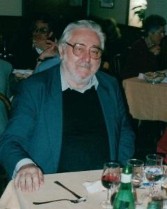EUROPEAN FAMILY THERAPY ASSOCIATION
CONNECTING FAMILY THERAPISTS AND TRAINERS
Luigi Boscolo
(1932-2015). He became a pediatrician at the Medical School of Padua, then a psychoanalyst in New York City (1960-1967)

Robin Routledge: Luigi told me once he was walking by a canal as a boy when a Mustang fighter airplane came and strafed the barges in the canal. Bullets hit the ground near Luigi. The plane circled around and came back extremely low with the pilot waving to him. One day he took me to a vegetable market in Milano and showed me how to shop for the best price and best quality. He grew up the son of a market gardener.
Whenever a hearse or funeral procession went by us, Luigi would touch his crotch. When he touched Gianfranco’s casket, he touched himself without thinking. He told me this is an old tradition he learned as a boy in the Laguna of Venice to ward off evil and to declare truth: it is a testament and comes from the word testicle. He had become unaware of it.
Umberta Telfener: At the beginning of the ’80 I spent one day twice a month at the Milan Center of Boscolo and Cecchin in order to train as a teacher of their school. I live in Roma, there were no fast trains at the time and I would wake up at 4.30 in order to go to Fiumicino airport and take the plane. Many times because of the fog we would land in Genova and then have a more than two hours bus ride. The classes would start at 10. When I arrived I had already spent half a day moving. Every time Boscolo would see me, he seemed very cheerful and happy: “Ciao Umberta, nice seeing you! It’s a pleasure.” We would end the day at the bar Virgilio, commenting on what had happened in the class. “Which school do you belong to?” he would ask me nearly every time. You can imagine my disappointment. I never understood if he really thought of me as a Roman, and therefore not a student of their school or if he was trying to motivate me. I regret I actually never asked him, I just felt a little frustrated and sad.
Luigi was very surprised that Anna Castellucci and I have been single for long periods of our lives. He would tell us he thought it was a shame, that he thought we were intense and full of positive energy and then give us suggestions to become more seductive: “When you are in front of a man, sitting at a table together, you should move your index finger on the top of the glass you have in front, with a intense look in your eyes. Look at a man straight in their eyes, promising intimacy”. Anna and I still laugh at his suggestions and when we are together we often try and circumnavigate the glass with our fingers!!
Premises – he used to say – are like the soles of the feet. You cannot see them because you stand on them.
Marco Bianciardi: We are in 1980. The year before, not yet thirty, I had started my training in via Leopardi in Milan with Boscolo and Cecchin and I was enthusiastic about it. I felt that it was opening up hitherto unimaginable perspectives of freedom of thought for me.
Unexpectedly, I had the opportunity to participate in a training group with Maurizio Andolfi in Rome: some colleagues from Turin had contacted Maurizio to start training, and he had replied that they had to form a group of students from Torino, so they proposed me to participate to the group.
My thirst for learning and training was such that I accepted, however without in any way questioning the training I was undergoing in Milan. So I began to attend an intense training weekend in Rome once a month, continuing to go twice a month to Milan for training at the Milan Center.
However, I felt embarrassed, I didn’t know if Luigi and Gianfranco would have understood and accepted my decision or if they would have considered it a ‘betrayal’, or, in any case, a confusing and counterproductive choice for my training path. So I decided to take courage and talk about it to the ‘Milan’ masters.
In those years the annual residential meeting of the students took place on Monte Isola, a small island in the middle of a small lake in northern Italy – a location that helped to isolate oneself and concentrate on dialogue, research and discussion. It was in that context that I found a moment to approach Luigi and ‘confess’ to him – very fearful – my decision to superimpose two different training paths.
His response – immediate, spontaneous, accompanied by a broad smile – was one of the most precious teachings I’ve ever received; giving me a benevolent look, full of respect, and also, I would say, of esteem, he simply said: “Excellent choice: as Gregory Bateson says, ‘Two points of view are better than one’!“.
Gloriana Rangone: I enthusiastically attended the training in Via Leopardi and followed the sessions of our teachers Boscolo and Cecchin together with colleagues. One day we attended a session conducted by Boscolo with a quarrelsome married couple who could not agree on anything. I remember our dismay when Boscolo raised both arms and said ‘I give up! You are suffering from malignant symmetry!” Amazed and intrigued, we wondered what would happen as a result of that unexpected intervention. Our amazement grew when at the next session the couple showed up smiling and in agreement, extraordinarily united to prove the therapist wrong.
We were all fascinated by the power of the intervention and also seduced by the idea of being able to transform that feeling of inability and disorientation we were experiencing in conducting our first sessions into a powerful move for change. So, it was that some of us fell in love with this intervention and decided to implement it in our own professional context. It is not difficult to imagine the consequences we, young therapists in training, faced when we tried to transfer what we had seen happening before our eyes to our Institutional contexts (certainly not prestigious like Via Leopardi!) in which we held marginal or non-chief roles. We were nevertheless able to laugh at our naivety and learn valuable lessons from that experience.
A lot of time has passed since then, but even today, when a student proposes a case for discussion or I supervise in training, I usually pay special attention to the context and role aspects. And the image of my teacher raising his arms and declaring his helplessness often comes to mind and reminds me that the most important learnings often occur in unpredictable circumstances.
When this happens I am overwhelmed with feelings of gratitude towards Boscolo. As well as, of course, an irrepressible urge to laugh….
Judith Landau: We had presented keynotes at the first East-West Bridging Conference in Prague in 1986. This was an historic event designed by Janos Furedi of Hungary, Donald Bloch and Lyman Wynne of the United States, and Helm Stierlin of Germany. Two years later, after the second bridging conference in Budapest in 1987, it became the International Family Therapy Association. It had been a rather strange event: 15 of us, identified as “prominent leaders,” were on the platform for 1.5 hours, each one of us tasked with leaving space for the next. Only the first six presented including Donald Bloch, Janos Furedi, Buda Bela, Harry Goolishian, Kitty la Perriere, and Gianfranco Cecchin. The rest of us were left speechless including Luigi Boscolo, Dick Auerswald, Ross Speck, Ivan Boszormenyi-Nagy, Virginia Satir, Lynn Hoffman, and me. As a result, we were brimming with excitement about our topics and ended up continuing to talk through the entire night. We had several points in common, and many differences. I wanted to include past generations and cultures, turning the clock back to understand the present and design the future. Luigi wanted to stay in the present and remain objective and observant. Our main point of agreement was that, not being surgeons, we did not have to cut and throw parts away, but that we could control time and play with it in each of our models.
Silvana Garavello: In June 2006, I organized an International Workshop in Belo Horizonte – Brazil – with Dr. Luigi Boscolo aimed at training therapists in the Milan Approach. At the time, Boscolo requested that we have volunteer families for live care.
A family came to us where a 18 years old son had attempted suicide. Thus, according to the program, after explaining the theoretical part, we begin the practical one.
This family arrived for treatment and Boscolo introduced himself. The family was made up of father, mother, the “identified patient” being the eldest son, his sister, 15 years old, and the youngest, 8. Boscolo began the session by asking each person to introduce themselves, the young man did not want to speak. His parents tried to force him but Boscolo interrupted their efforts, saying that if he didn’t want to talk, it was fine.
Each member introduced themselves and, through circular questions, asked each family member, in their opinion, what the problem was. The 15-year-old daughter, very lively and talkative, together with her younger brother, answered the questions very calmly. The father in the meanwhile interacted with the younger children, smiled and demonstrated positive energy, always holding his wife’s hand. The identified patient, sitting next to his mother, remained silent and with his head down. Dr. Boscolo addressed the father, asking him about his family of origin, their history and the reason that brought them to care. The father, very simply, reported his humble origins, his commitment in raising his children, how proud he was of his family and his concern for his eldest son, as he no longer knew how to help him (all this time mother was crying). Boscolo then turned to mother and she spoke about her painful childhood, her starting working at a very young age to help with household expenses. She showed a great loss of energy, a distant look, always reinforcing the idea that she was very tired. When she stopped speaking, Boscolo told the family what he had understood about what had brought them to care: “It seems that you – addressing mother – have long seen yourself tired of life, how difficult and hard it has been. It seems to me that your son realized your deep sadness and lack of motivation and, understanding that you had given up but are very important for the family, understanding that everyone would suffer tremendously if you would give up, decided to die in your place, to protect the family.” When Boscolo finished his speech, the young man got up and ran out of the auditorium. Dr. Boscolo was unfazed and did not let anyone go and follow the young man. A colleague then offered to go out and Boscolo authorized it, as long as he didn’t ask anything, just if the boy needed water or anything else. The mother broke down in tears while the father hugged her. The brothers, without realizing what had been said, hug their parents. Silence took over the auditorium.
After a few minutes, the colleague returns and tells Dr. Boscolo that the young man wants to speak alone with him. Boscolo gets up to meet the young man. After a while, which for the 300 therapists who participated in the course had been long and silent, Boscolo returned to the auditorium together with the young man who, hugging his parents and siblings with great affection and emotion, said goodbye to Boscolo .
After the family left, Boscolo reported what had happened: the young man had shown him a tattoo on his arm with the words: “No one is capable of reading another’s soul”, he hugged Boscolo and stated he would like to become a psychiatrist, to help people heal their pain. Boscolo replied that he would be welcomed in Milan, at the CMTF.
Those present in the auditorium were moved by the story. Even today, whenever I return to CMTF, Jacqueline Boscolo and I talk about this session and how moving it was.
Massimo Schinco: Luigi Boscolo used to say about me: “Massimo Schinco is a poet“. I thought he was kindly teasing me. It took me years to understand how much he appreciated this thought of Bateson’s and consequently what he meant.
“It is told of Johann Sebastian Bach that when somebody asked him how he played so divinely, he answered, “I play the notes, in order, as they are written. It is God who makes the music”. But not many of us can claim Bach’s correctness of epistemology – or that of William Blake, who knew that the Poetic Imagination was the only reality. The poets have known these things all through the ages, but the rest of us have gone astray into all sorts of false reifications of the “self” and separation between the “self” and experience.” (Steps to an Ecology of Mind; Form, Substance, and Difference)
I thank Luigi form my heart, for repeatedly encouraging me to trust myself.
Jackie Pereira Boscolo: Luigi had already seen me because I was working as a dietician in the same hospital where Gianfranco was doing his internship in psychiatry in Westchester Park. Luigi was an intern in psychiatry as well in a Hospital in Brooklyn. Luigi told me later he thought I was a date of Checchin and did not dare court me. The two lived together, Gianfranco had a car which was a luxury. He used to bring many colleagues to the place of work, including myself. I also used to go to their home in Greenwich Village, a very spartan home. With Gianfranco’s partner we helped in making the apartment pretty: we painted the walls and restored it. Luigi used to meet me and ignore me. I was thin and beautiful but thought I was ugly.
I was living in New York with sixteen brothers and sisters. Gianfranco followed his internship with a step brother of mine who lived with us, they were friends. He became a big friend of my mother, he also loved my father, they talked together in French about culture and books. He brought Luigi with him every time we invited friends over.
For new year’s eve once they came together. My father and seven of my brothers were controlling me. Luigi told Gianfranco he would have liked to marry one of my sisters, since they were so beautiful. No hint on me. It was 1960 when I met him, I was 23 years old and he was 27. Nothing happened. One year had passed, the 29 of December there was a party of our University as every five years, a ball at Central Park South and I really wanted to go since many friends were there. I had a white dress with my hair held high, I must say I was charming. Luigi sees me and asks me to dance and whispers in my ear that he would like to marry me. We remained together ever since.



